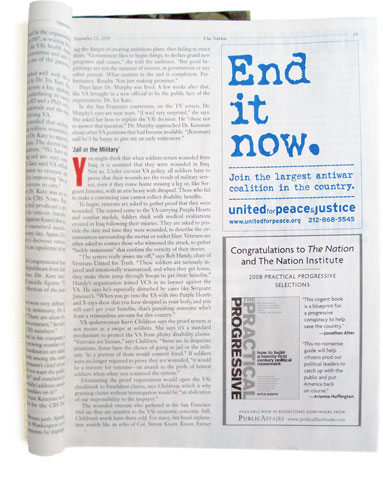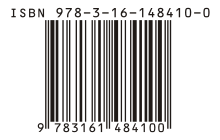September 2008
Represent
Alaska Women Reject Palin
There’s a special zing to criticism from “one’s own:” veterans against the war, 9/11 families critical of the memorial and investigation, or, say, Alaska women rejecting Sarah Palin.
Some are calling last week’s 1,500 strong protest in front of the Loussac Library in Anchorage the biggest political rally in the history of the state. The protest has reverberated throughout the Internet as well, forwarded by email and blog. As of this writing, Google turns up 19,100 hits. Propelling it along are photos of the cheeky, hand-made posters used at the event.
The protest started with a small group of women, talking over coffee. They printed up flyers, posted them around town, and sent notices to local media outlets. Word was also spread by a conservative radio host who mocked them on the air. No doubt the free publicity helped. Read more about the protest here.
Opland
It’s among the most recognizable images in Holland. The poster below was drawn by Opland, the pseudonym of Rob Wout, one of Holland’s most popular political cartoonists in the second-half of the twentieth century. For 53 years, from age 19 until his death in 2001, Opland drew caricatures and political cartoons for De Volkskrant and De Groene Amsterdammer. In 1981, at a high point in his career, Opland contributed this cartoon to the anti-nuclear movement. The slogan reads ‘No new nuclear weapons in Europe.’ It became one of his most famous images in the peace movement outside the Netherlands, as well. The image is a nice mix of humor and outrage, clarity and simplicity, with a dash of familiarity. How could you say no to her?

The anti-nuclear movement in Holland had been active through the late-1970’s and in 1978 an unexpected coalition of Communists, leftists, and religious groups organized nation-wide protests and petitions that successfully pressured the center-right government to disallow U.S. neutron warheads in the Netherlands. However, a year later Prime Minister van Agt endorsed NATO plans to deploy additional U.S. nuclear warheads to Holland, though in deference to domestic pressure, postponed a final decision. Citizens were outraged and took to the streets, holding one of Amsterdam’s largest protests ever in November 1981. American pundit Walter Laqueur coined the term Hollanditis to describe the movement and its influence on other European countries, particularly West Germany. Around a quarter of the population of the Netherlands signed a petition against the deployment and the movement culminated in a record-breaking one million strong demonstration in The Hague in 1983. In May 1984, a nation-wide week of protest was held and 900,000 people participated in a 15-minute general strike.
Still, on November 1, 1985, after the Soviet Union failed to comply with a Dutch ultimatum and in a period of escalating cold war tensions, the Dutch parliament voted to allow 48 American missiles on Dutch soil, to deploy by 1988. In the end, the new warheads never arrived. In 1987 the Presidents Reagan and Gorbachev signed the Intermediate-Range Nuclear Forces Treaty to eliminate intermediate range missiles.

End It Now.
An ad I designed for United for Peace & Justice ran in the September 15, 2008 issue of The Nation. The ad runs along side the cover story on the U.S. government’s shameful treatment of veterans.
It’s nicely bold and direct in print. It’s also the first time UfPJ ran with copy I came up with. In the design process I showed a couple of sketches using the text they’d provided, and a couple without.

Here are a couple of previous projects for UfPJ.
Local Number Portability
 Two friends have self-financed a book themselves, from design to printing, and are now scraping together cash to fund a second print run. The publisher has been of little help, providing some distribution and order fulfillment, but not much else. Given that the first printing has mostly sold out, I asked why they don’t find a more invested publisher to help fund the second run. The response: the ISBN number, a book’s unique commercial identifier, can not transfer from one publisher to another. Publishers purchase blocks of ISBN numbers, and the number includes a segment that identifies that publisher.
Two friends have self-financed a book themselves, from design to printing, and are now scraping together cash to fund a second print run. The publisher has been of little help, providing some distribution and order fulfillment, but not much else. Given that the first printing has mostly sold out, I asked why they don’t find a more invested publisher to help fund the second run. The response: the ISBN number, a book’s unique commercial identifier, can not transfer from one publisher to another. Publishers purchase blocks of ISBN numbers, and the number includes a segment that identifies that publisher.
Sure, you can always get a new ISBN number, and are encouraged to do so, if the book has significant changes. But given the multi-year struggle to get the first edition out, significant changes are unlikely soon. You can also get an ISBN number yourself, but this may preclude working with an existing publisher. And before you ask, this specific book doesn’t make sense as a PDF download. It’s a large-format art book.
Because much of my casual reading is on the internet, a large degree of data portability seems normal and natural to me. I suppose publishers should have some protection of their investment in a book to prevent others from poaching a successful product. But it seems to me like this should be a contractual obligation not something baked into the standard book identification system!
Update, 9/13/08: Morris Rosenthal, whose site I link to about obtaining an ISBN, sends this clarification:
“You’re correct that the ISBN ties an edition to a publisher, that’s baked into the system. But if your friends own the rights to the book, they don’t need to make any changes to release a new edition with a new ISBN, it will simply be a different edition from a different publisher, even if the publisher is them. There aren’t any laws about how ISBN’s must be used (even though the ISBN agency, Bowker, is a government granted monopoly in the US), some small publishers even release totally new edition WITHOUT changing the ISBN, so they don’t risk losing the built-up position on Amazon.
If you’re curious, here’s a recent piece I wrote on revised editions.”



